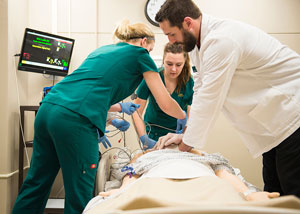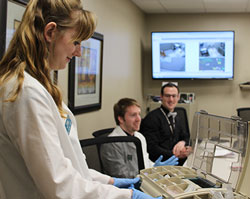
March 10, 2017 – Fargo, North Dakota – “Clear!” along with audible 30-second counts are heard as North Dakota State University students take on their roles to learn how a team must seamlessly work together in an emergency situation. Carl Shapiro serves as their patient—talking, breathing and exhibiting signs of distress.
In class sessions, more than 130 pharmacy and nursing students learn how to quickly react in simulated code situations during each semester at NDSU. It’s part of interdisciplinary and high tech education in the NDSU College of Health Professions to prepare students for future healthcare careers.
Simulation Lab instructors control Carl, the high-tech patient. Via computer, they can change his breathing, speaking, status, heart rhythms and other functions. The lab provides third-year pharmacy students and senior nursing students an opportunity to work together as a team. The investment to offer such sessions includes the high-tech mannequins, which can cost more than $80,000 per mannequin.
Students learn various team members’ roles under critical scenarios that require expertise in a fast-paced team environment for optimum patient outcomes.

“The simulation allows students to learn the code algorithm for care and the medications associated with acute cardiac life support (ACLS),” said Kristopher Wensmann, pharmacy practice resident leading the activity during the academic year.
Students are assigned roles in the Simulation Lab experience, administering CPR and medications, recording each step, using a defibrillator, learning closed-loop communication among the team, and how they might react in an emergency situation. Sessions are video-recorded and the team reviews their performance with instructors, gaining valuable knowledge.
“Having solid interprofessional skills is important because the healthcare field depends on so many different professions working together,” said Wensmann. “This simulation is one way to help students to see the larger picture and become more aware of their role in healthcare and where their role can be improved.”
Pharmacy and nursing classes began this joint training in 2015 at NDSU. The Simulation Lab offers a unique educational experience for students.
“To be able to work as a team, foster good communication among all team members, and to feel comfortable to be able to initiate a code if they witness one happen,” are some of the benefits, according to Maggie Mackowick, assistant professor of practice in nursing.
Wensmann views the training as critical. “Communication, leadership, professionalism, and being able to think and react in high stress situations are some of the opportunities for growth.”
Providing the team approach to both nursing and pharmacy students in the code simulations makes NDSU’s program unique.
Third-year pharmacy student Susan Lyons plans to eventually work in a community or hospital pharmacy. She said one aspect of the training stood out. “How well we (pharmacy students and nursing students) worked together, without knowing each other or having ever worked together before. I also liked how well this simulation represented real-life situations,” said Lyons.
Such training is valuable, according to students. “I always thought a situation like this would be chaotic with poor communication, but during this simulation, it showed how well healthcare professionals work together and communicated in order for things to be recorded,” according to Lyons.
Pharmacy student Mai Hoang used a defibrillator during a code training session and notes that team members stayed calm and on task. “I learned how to read and differentiate the rhythms, such as ventricular fibrillation and ventricular tachycardia. I also learned how to communicate and collaborate with other team members in a stressful situation.” 
Healthcare employers seek graduates who are adept at team-based care that involves multiple professions, and accrediting bodies are urging program leaders to emphasize interprofessional collaboration.
“Recognizing that the roles for future pharmacists are ever expanding, we also are making strides within our curriculum,” said Charles Peterson, dean of the College of Health Professions at NDSU. “Through efforts such as the Simulation Lab experience and other initiatives, we are preparing students to be part of an interdisciplinary healthcare team that serves a variety of patients, clients and needs.”


